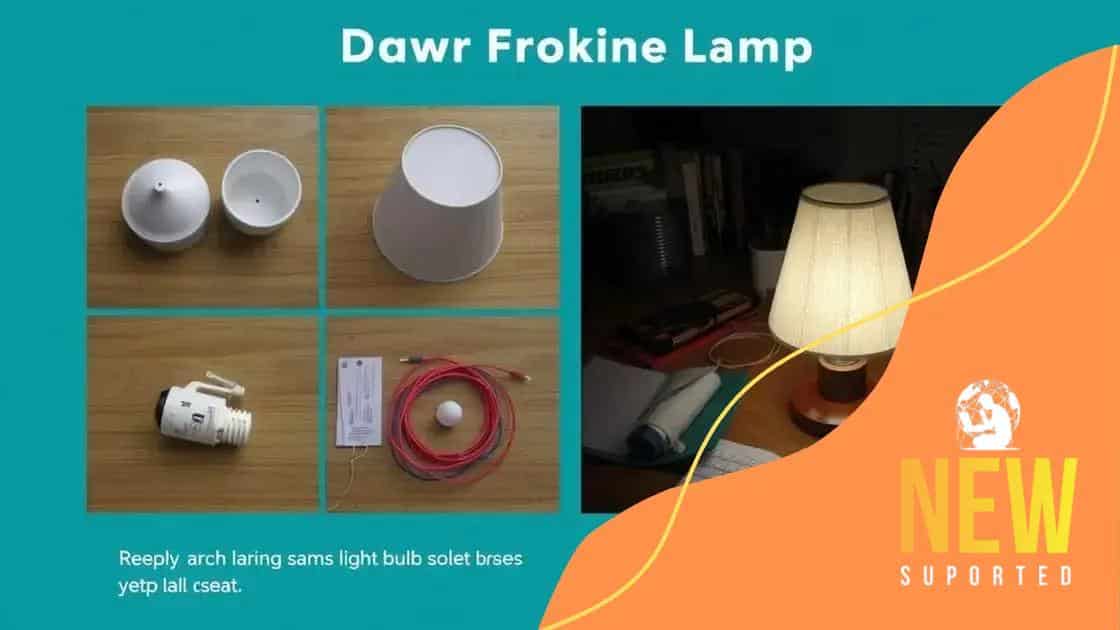DIY lighting projects to brighten up your space

DIY lighting projects offer creative and functional ways to enhance your home, utilizing various materials, innovative designs, and strategic lighting techniques to create a warm, inviting atmosphere.
DIY lighting projects to brighten up your space can transform any room into a cozy haven. Have you ever thought about how the right lighting can change your mood? Let’s explore some fun and creative ways to add light where it’s needed most!
Understanding different types of lighting
When it comes to understanding different types of lighting, it’s essential to recognize how each kind can affect the mood and functionality of a space. Various lighting types serve distinct purposes, creating both ambiance and practicality.
Natural vs. Artificial Lighting
Natural lighting comes from windows, skylights, and other openings that let sunlight flood into your home. This type of lighting can enhance your mood and provide essential vitamin D, especially during the shorter days of winter. On the other hand, artificial lighting is generated from light fixtures and can be manipulated to fit your needs at any time.
Types of Artificial Lighting
There are three primary types of artificial lighting:
- Ambient lighting: This is the general light that fills a room.
- Task lighting: Spotlights or lamps used to illuminate specific areas for activities like reading or cooking.
- Accent lighting: Designed to highlight artwork or architectural features in your space.
Each type plays a crucial role in home design. For example, using a combination of ambient and task lighting can create a lively atmosphere, making your living room welcoming while still allowing you to focus on reading or working.
Additionally, think about the color temperature of your lighting. Warm light (yellowish) often provides a cozy feel, while cool light (bluish) can be more energizing and alerting. When choosing fixtures, consider how they complement your decor and their intended purpose. Experimenting with different styles can lead to exciting results, transforming your living space uniquely.
By combining these types effectively, you can influence the overall feel and functionality of your home.
Materials you will need for DIY projects
To successfully tackle DIY projects, it’s vital to gather the right materials beforehand. This preparation not only streamlines the process but also enhances your overall results. Understanding what you need can make all the difference in completing your lighting project efficiently.
Essential Tools
You’ll need a few essential tools for most lighting projects. Here are some must-haves:
- Wire cutters: Perfect for trimming wires to the desired length.
- Wire strippers: These help expose the copper wire without damaging it.
- Screwdrivers: Various sizes, particularly Phillips, will be useful for assembling fixtures.
Having these tools ready makes it easy to assemble or modify your lighting. Now, let’s move on to materials!
Electrical Components
When working on lighting projects, consider a few electrical components:
- Light bulbs: Choose the right type and wattage based on your lighting needs.
- Light fixtures: Select fixtures that complement your design style.
- Wire: Make sure you have the appropriate gauge for your project.
Gathering these components ensures that you can create a sturdy yet stylish lighting solution for your home.
In addition to these basics, consider design elements. You might need decorative items like lamp shades or wiring covers for a more polished look. Remember, the right combination of materials not only allows for functionality but also boosts aesthetics.
Step-by-step guide to creating your own lamps

Creating your own lamps can be a rewarding project that adds a personal touch to your space. Follow this step-by-step guide to design and assemble unique lighting fixtures.
Gather Your Materials
Before diving in, collect all the necessary materials. You’ll need:
- Base: This can be a repurposed item like a bottle or an actual lamp base.
- Socket: A light bulb socket suitable for your chosen bulb type.
- Electrical wire: Ensure it’s the right gauge for your lamp.
- Light bulb: Choose one that fits your style and desired brightness.
Having everything in place will make the process smoother.
Assembling the Lamp
Start by securing the socket to the base. If using a decorative item, make sure it can support the socket.
Next, feed the electrical wire through the base. Connect the wires to the socket according to the manufacturer’s instructions. Remember to strip the ends of the wire to expose the copper and twist them securely to the socket terminals. This step is crucial for safety.
Once your connections are secure, attach the lamp shade, if you have one. Make sure it is the right fit and complements your design. If you need to drill holes, take extra care to prevent damage to the base.
Testing Your Lamp
Before finalizing everything, plug in the lamp to test it. Make sure that the light bulb works and that there are no faulty connections. If everything looks good, turn off the power, secure the socket, and ensure all parts are tight.
Don’t forget to choose a spot in your home where the lamp will look its best and also serve a practical purpose. Lighting can dramatically change a room, so think about how your new lamp will fit into your existing decor.
Innovative ideas for unique lighting designs
Exploring innovative ideas for unique lighting designs can breathe new life into your living space. Unique lighting not only enhances the aesthetics of your home but also reflects your personal style. Let’s dive into creative approaches that can transform ordinary fixtures into extraordinary statement pieces.
Upcycled Materials
Consider using upcycled materials for a sustainable lighting option. Items such as mason jars, old bottles, or even wooden crates can be reimagined as charming light sources. For example, a mason jar pendant can create a rustic vibe, while a repurposed bottle can add a modern touch. Using materials you already have can save money and reduce waste.
Colorful Light Bulbs
Incorporating colorful light bulbs can instantly change the mood in a room. Explore options like LED bulbs that can shift colors or dimmable options. These can help create different atmospheres depending on the time of day or occasion. Experimenting with hues like warm yellows or cool blues can make your lighting truly unique.
Layering Light Sources
Another innovative idea is to layer various light sources for depth and interest. Combine pendant lights, table lamps, and wall sconces to create a dynamic lighting scheme. Mixing styles, such as contemporary with vintage, adds character to your space. This technique enhances functionality while crafting a visually interesting environment.
Don’t forget to incorporate accent lighting to highlight specific areas or decor pieces. For instance, a spotlight on a piece of art can draw attention and add sophistication.
Lastly, consider unique fixture shapes. Go for geometric designs or organic forms that can serve as art themselves. These can become focal points while providing the necessary illumination.
Tips for enhancing ambiance with DIY lights
Enhancing ambiance with DIY lights can make your home feel more inviting and comfortable. With a few thoughtful tips, you can create a warm environment that reflects your style.
Layering Your Lighting
Utilizing different light sources is key. Layering your lighting can offer versatility. Include ambient, task, and accent lights in each room. For instance, combine overhead lights with table lamps and floor lamps to create depth.
Choosing the Right Bulbs
The type of light bulb can significantly impact mood. Use soft white bulbs for a cozy feel. If you want energy, opt for bright white or daylight bulbs. Experimenting with color-changing LEDs can also add excitement and dynamic ambiance.
Creating Focal Points
Consider highlighting specific areas or objects. Use DIY lights to draw attention to artwork or architectural features. Spotlights or decorative strings of fairy lights can serve this purpose well. This creates a sense of warmth and comfort.
Furthermore, think about your light placement. Positioning lights at various heights creates visual interest. Hanging lights, wall sconces, or floor lamps can change how a space feels.
Using Natural Elements
Incorporate natural elements into your DIY lights. This can include using wooden bases for lamps or weaving lights through plants. These touches can soften the atmosphere and connect your indoors with nature.
Don’t forget seasonal changes! Switch your lights according to the seasons or holidays. Cozy string lights in winter can be light and airy in summer.
FAQ – Frequently Asked Questions about DIY Lighting Projects
What materials do I need for DIY lighting projects?
You will typically need a base, sockets, electrical wire, light bulbs, and any decorative items you wish to use.
How can I enhance the ambiance of my home with DIY lights?
Try layering different types of lighting, using colorful bulbs, and creating focal points to set the mood.
Are there sustainable options for DIY lighting?
Yes, using upcycled materials like jars or old bottles is a great way to create sustainable and unique lighting fixtures.
What are some innovative lighting designs I can try?
Consider geometric fixtures, integrating natural elements, or using color-changing LEDs to create dynamic lighting effects.






